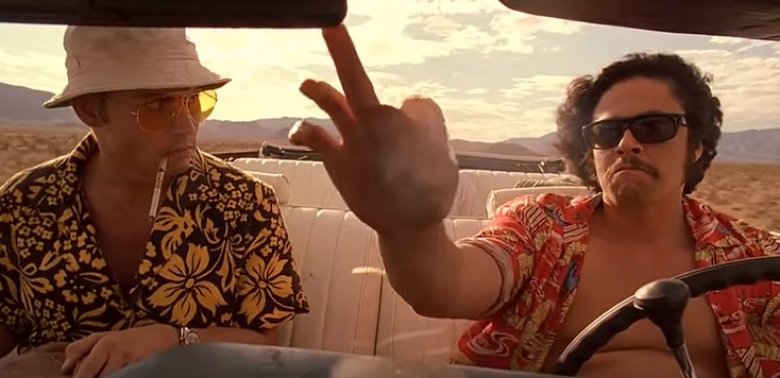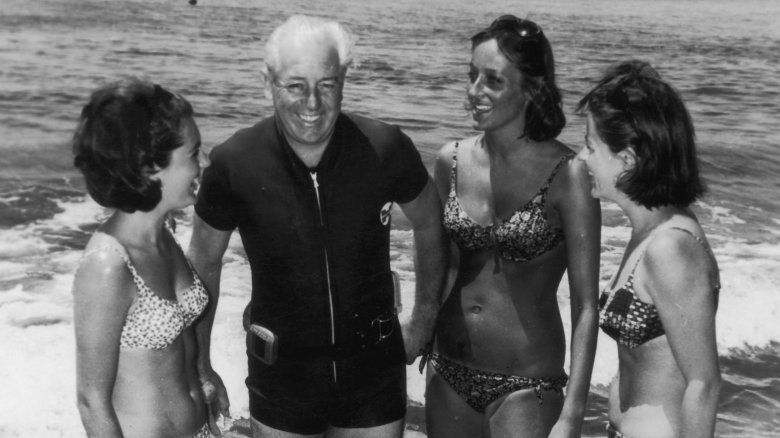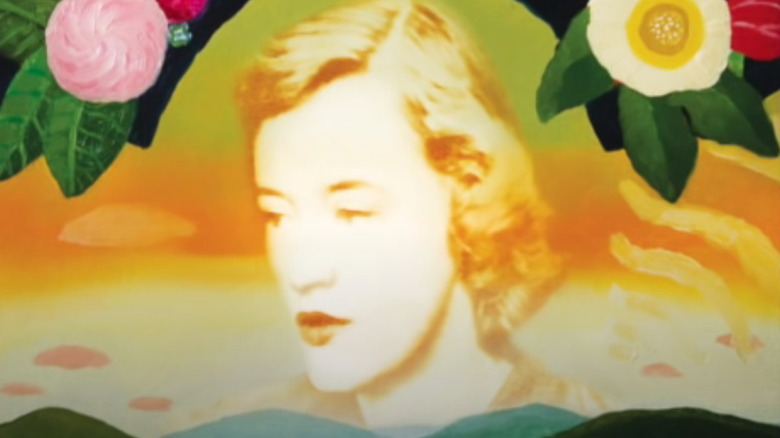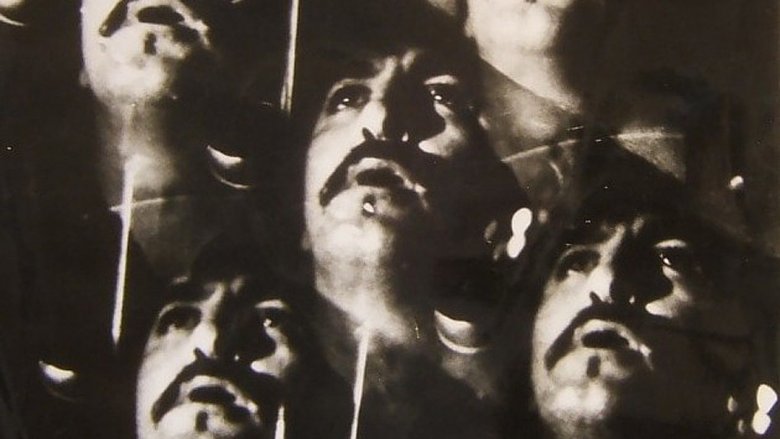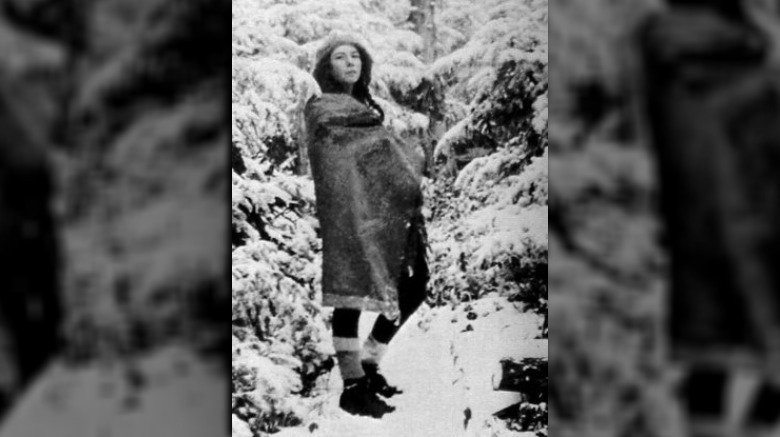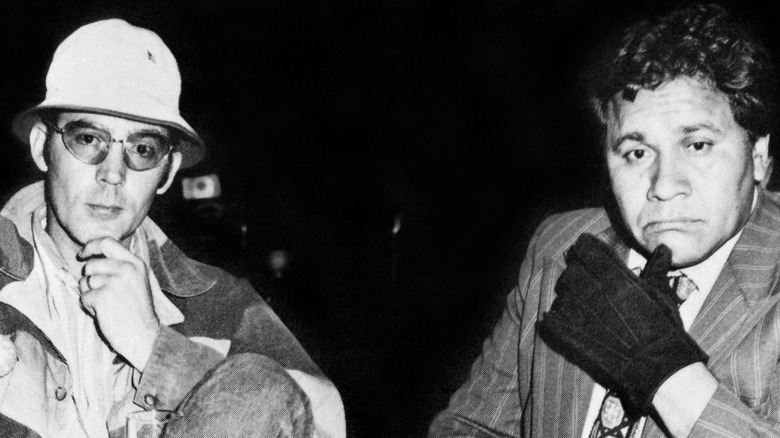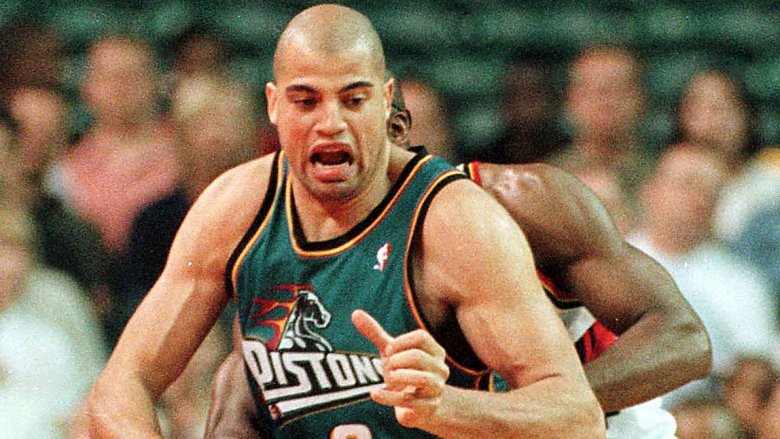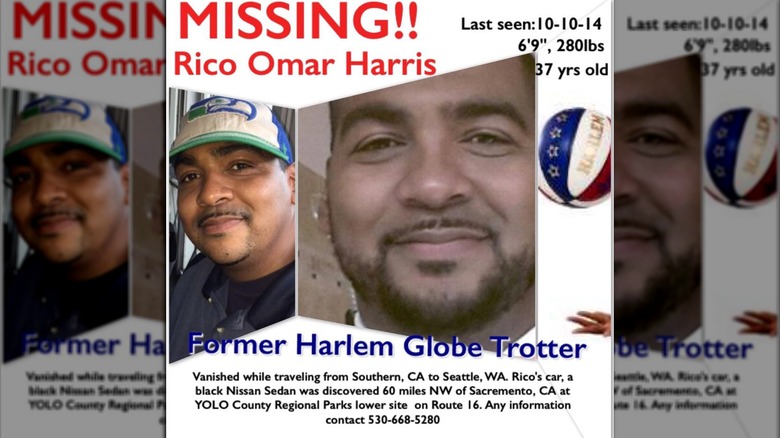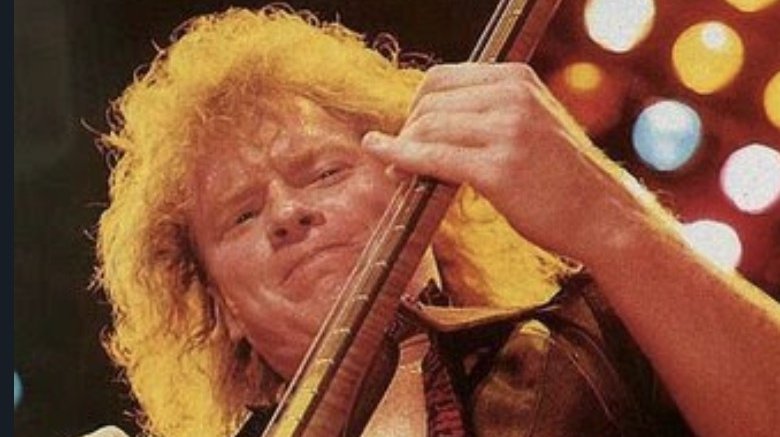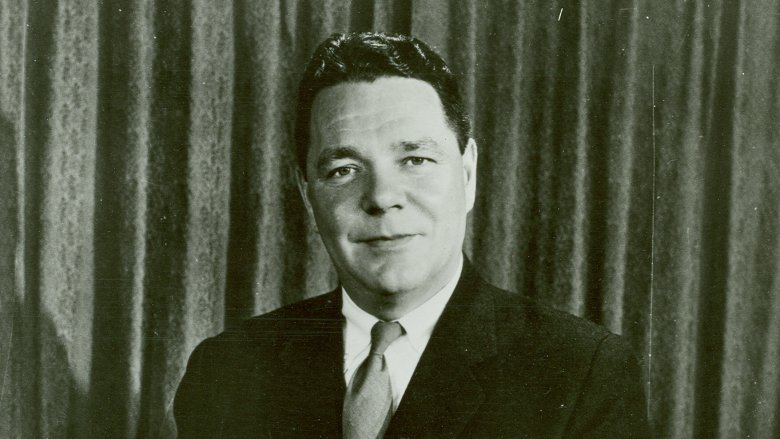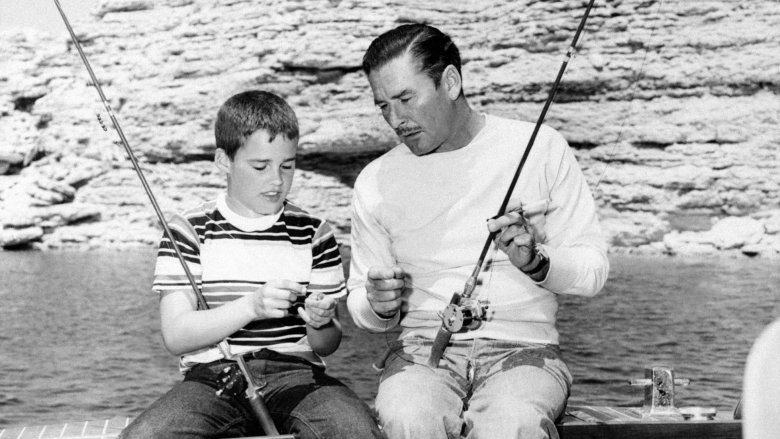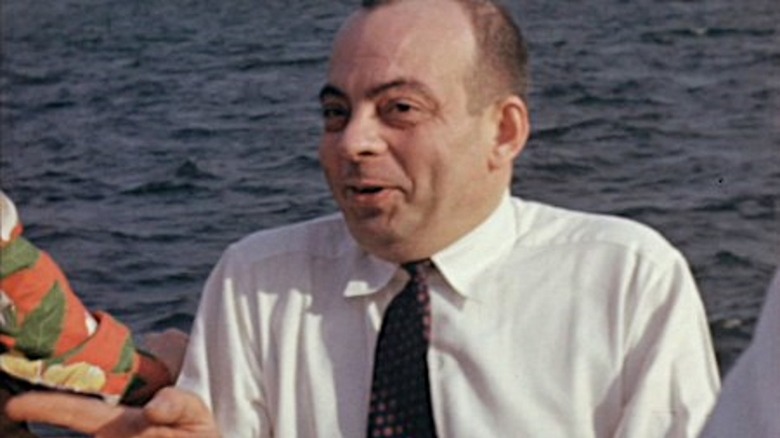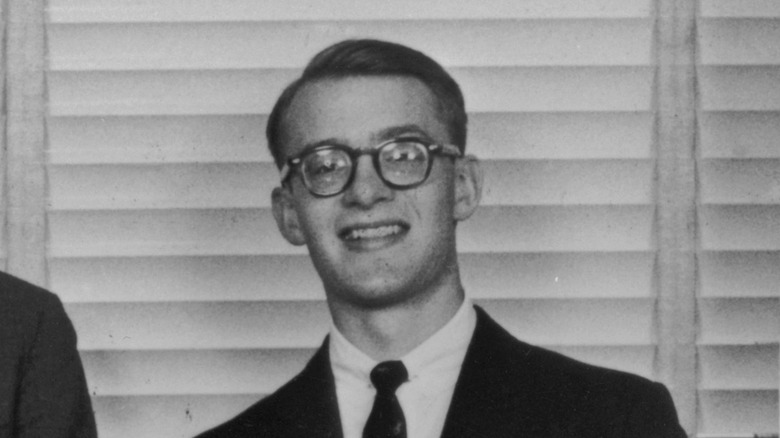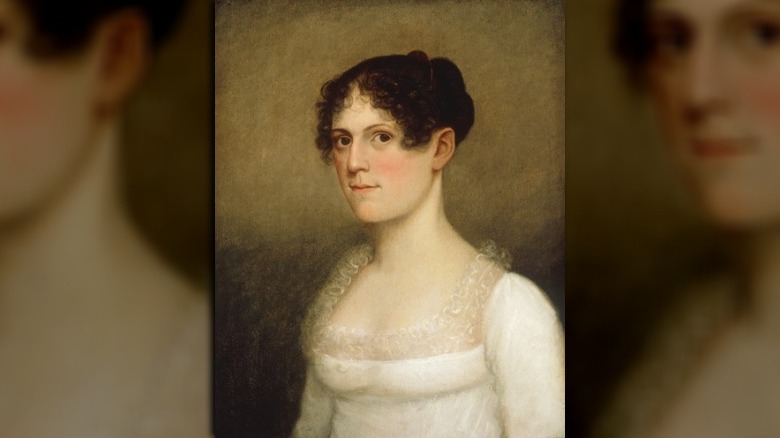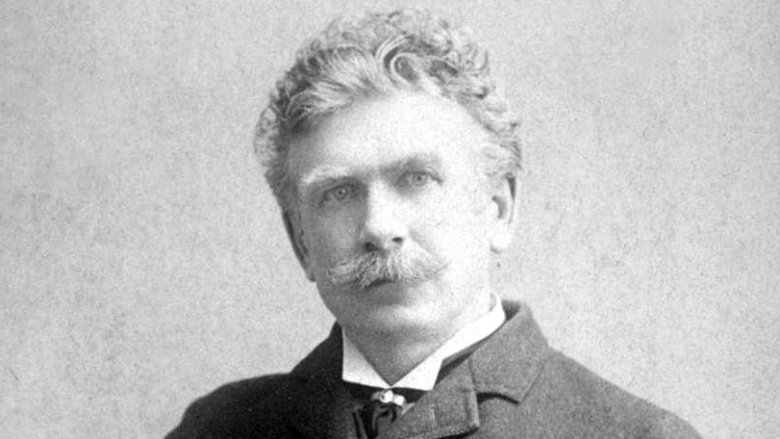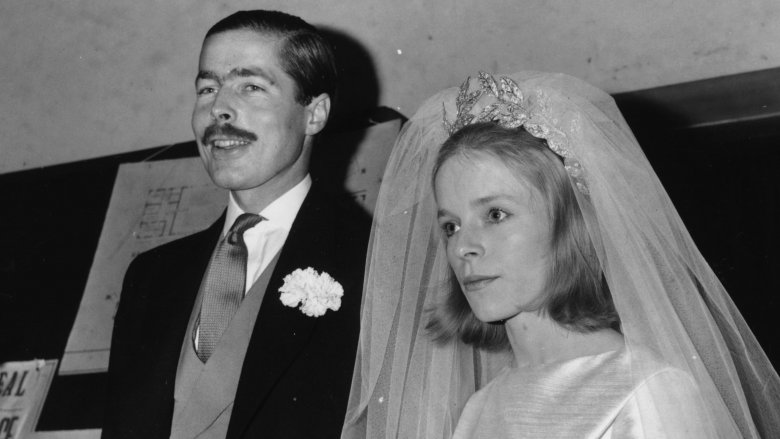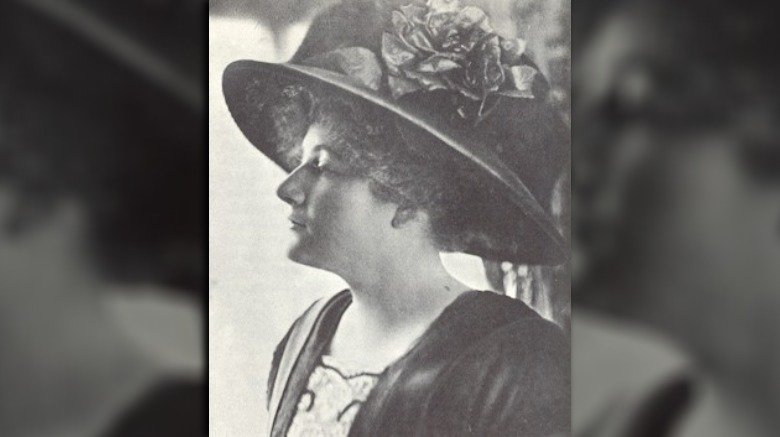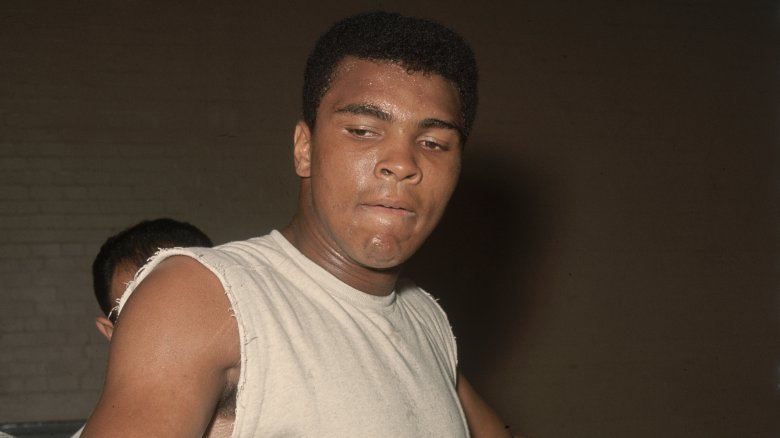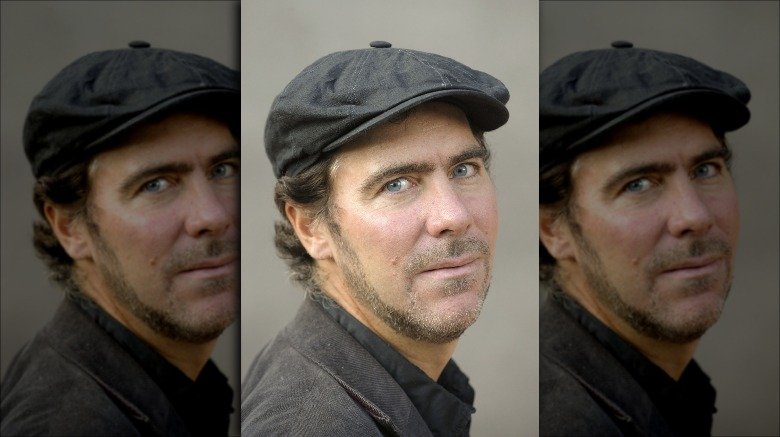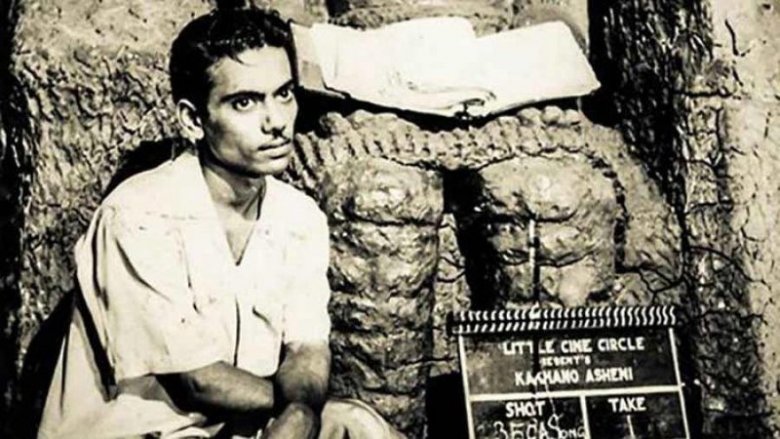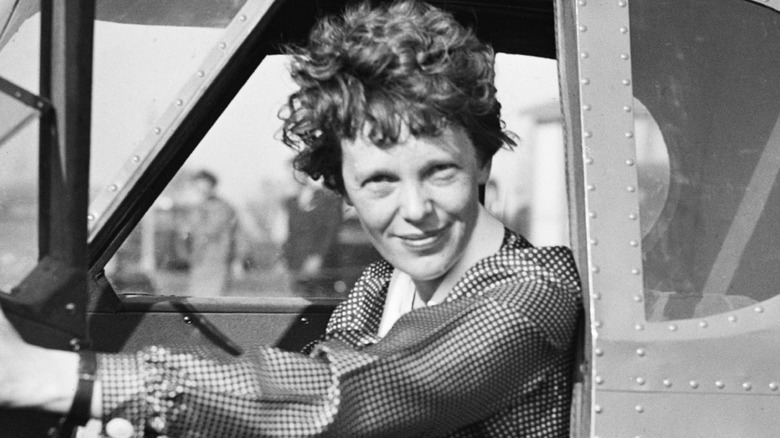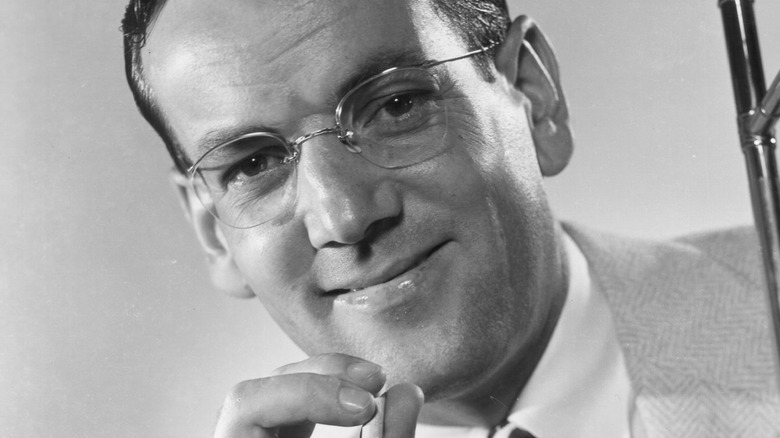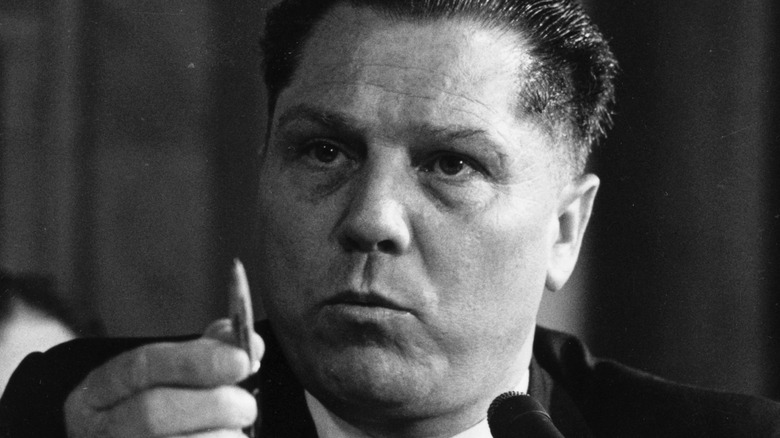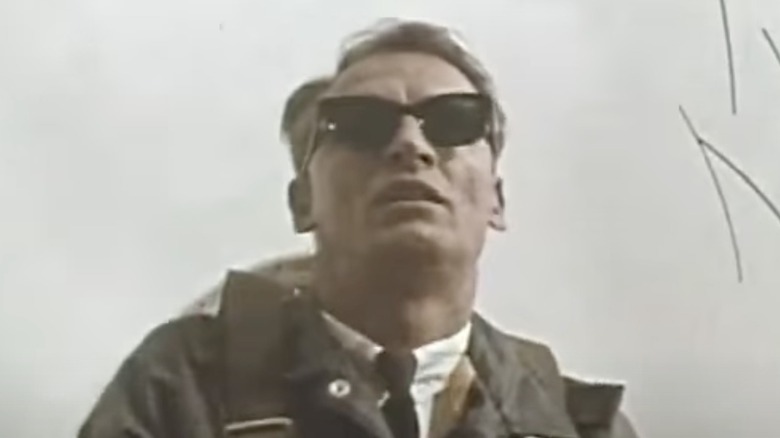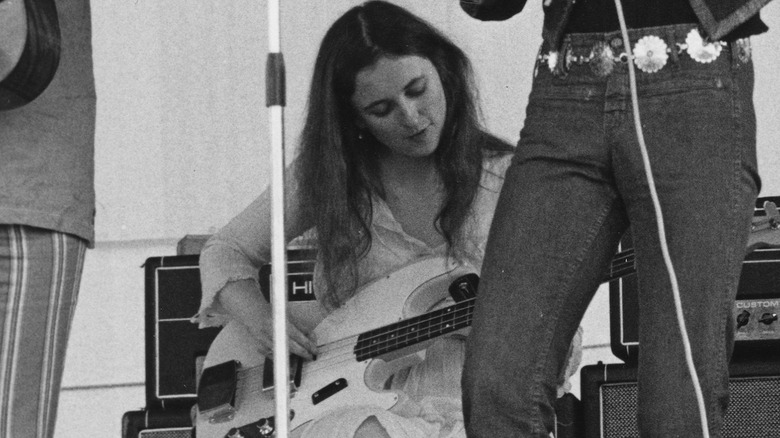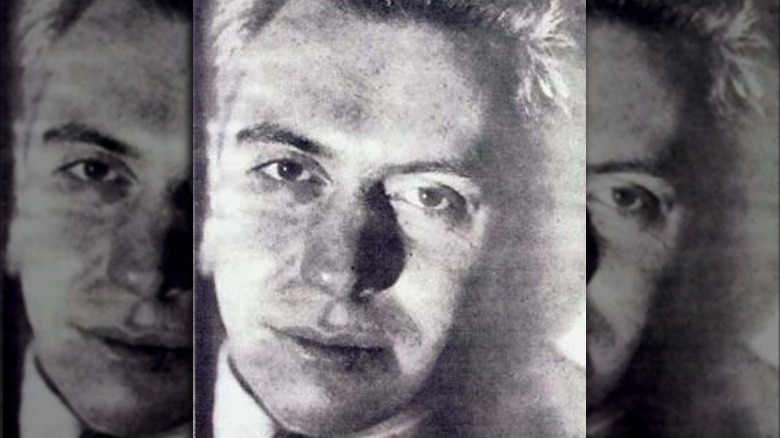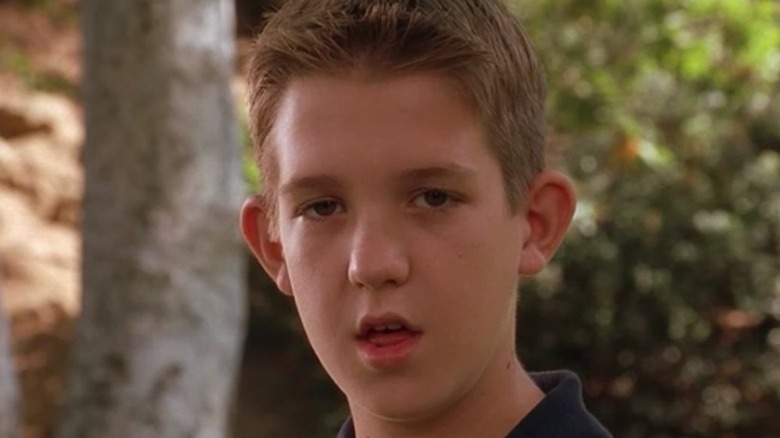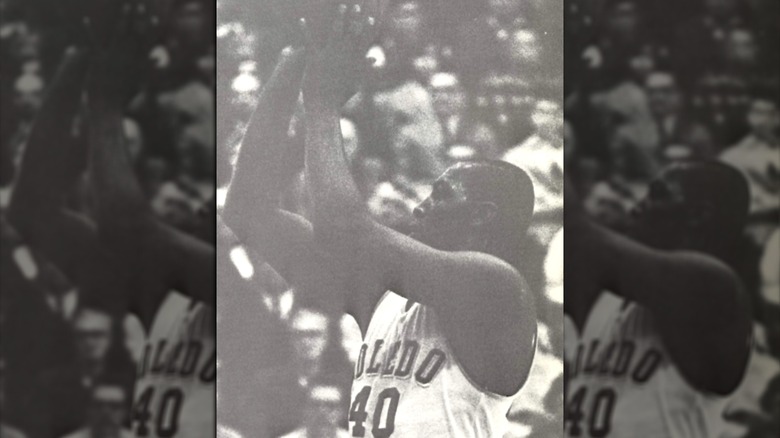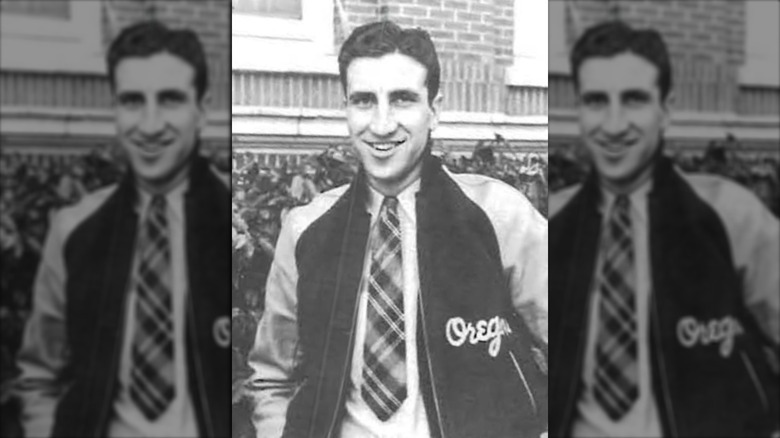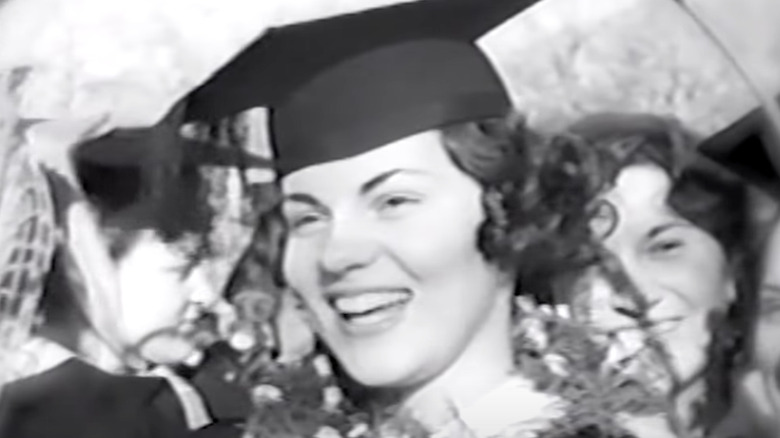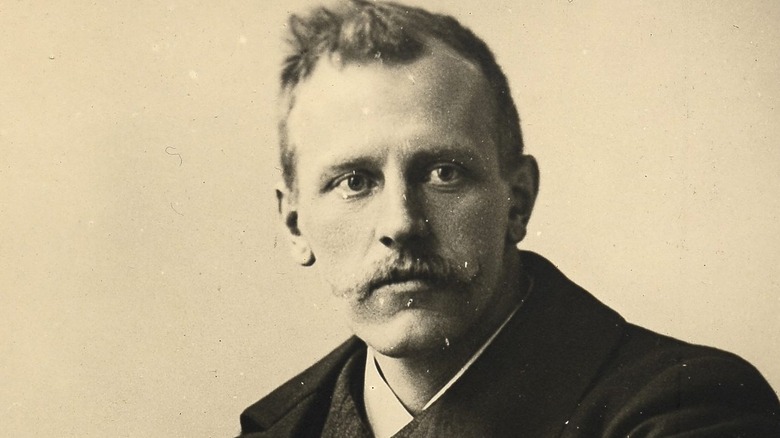Celebs Who Are Still Missing Today
It ain't easy pulling off a successful vanishing act. Just ask someone like Steven Leung, who tried to make it look like he'd died during 9/11. Or the British "canoe death dad" John Darwin, who disappeared, cashed his life insurance policy, and then was spotted trying to spend his dough in Panama. And these bozos were just boring, ordinary guys. Imagine how much more impossible it'd be for someone like Justin Bieber to vanish without a trace. How very sadly impossible.
Yet sometimes, the impossible happens. Over the years, a handful of real, actual celebrities have vanished. People who shouldn't be able to walk down the street without getting noticed, but who somehow manage to slip away into the night, never to be seen again. If any of the disappeared celebs below happen to look just like your mysterious new neighbor, now might be the time to claim some reward money.
Richey Edwards (Vanished: 1995)
Imagine if Lord Byron, Sid Vicious, and a moody teenager all managed to magically stew their sperm to create a hybrid baby. That baby would look and act a whole lot Manic Street Preachers' rhythm guitarist and lyricist Richey Edwards, a mid-1990s British rock idol whom The Guardian called "a lightning rod of sorts for adolescent angst."
Edwards was handsome, moody, and dreamy, with a talent for writing lyrics about depression, and an even bigger talent for disturbing publicity stunts. When a journalist with music magazine NME implied his band's posturing was insincere, Edwards grabbed a razor blade and carved "4 REAL" into his own arm. When he first went missing, in February 1995, it could've just been another chapter in his twin stories of self-destruction and self-promotion.
No such luck. It quickly became apparent that the young poet was gone for good. Edwards had been due to fly to the U.S. with MSP front man James Dean Bradfield when he disappeared from his hotel room. His car was later found abandoned near the Severn Bridge, which connects England and Wales. (It's kinda like finding an abandoned car next to the Golden Gate Bridge.)
Edwards was legally declared dead in 2008, but no body has ever surfaced. NME reports that sightings of the musician have reached as far as Goa. And, published in 2019, "Withdrawn Traces: Searching for the Truth About Richey Manic" alleges that Edwards "staged his own disappearance." Given his history of mental illness, it seems unlikely he's still out there, but you never know.
Harold Holt (Vanished: 1967)
Everyone in a cruddy job dreams about disappearing. Only one of those people has ever been prime minister of Australia (at least, if you believe the conspiracy theories). Harold Holt was nearly two years into his term as Australia's 17th leader when, one December day in 1967, he decided to go swimming at deserted Cheviot Beach in Victoria. He never returned to shore. With a feeling of national embarrassment, Australia discovered it had managed to misplace an entire prime minister.
The weather at Cheviot Beach was atrocious that day. As Smithsonian recounts, one person at the scene claimed the surf was higher than he'd ever known it. Although Holt's body was never recovered, a 2005 investigation concluded he'd drowned (via The Telegraph). That didn't stop the conspiracy storm clouds from gathering. Imagine if JFK's body had vanished after his shooting. That's the sort of ultra-combustible conspiracy fuel this is.
The paranoia fires were fanned by the lack of an official inquest. An Australian law at the time (amended 18 years later) made it illegal to conduct an inquest into someone's death without a body, even when that someone was the leader of the country. In a strange postscript, the state of Victoria decided to commemorate Holt with a memorial swimming center. Ouch. That's a little like commemorating JFK with a memorial open-top car ride around Dallas.
Connie Converse (Vanished: 1974)
Here's some advice for any disappointed artists out there. Just because no one likes your stuff now doesn't mean hipsters won't one day be discussing how underrated you are. Just look at Connie Converse. A 1950s musician, she's now considered the first modern singer-songwriter, crooning intimate, lyrical ballads suffused with melancholy at a time when Bob Dylan was barely out of diapers (via BBC). Not that her contemporaries were aware how groundbreaking Converse was. In 1961, she quit music altogether, unknown and convinced she was a failure.
In a happier universe, Converse's tale would now take a redemptive turn. In 2009, a handful of songs she'd recorded in the kitchen of Gene Deitch were released by Deitch's record label. The album, "How Sad, How Lovely" became a cult hit. The New Yorker profiled her. Sadly, Converse saw none of this success. She disappeared in 1974.
'74 was a bad year for Converse. She'd just turned 50, and she felt like a failure. That summer, she wrote to her friends that she was going to make a fresh start, loaded up her car, and drove off into legend. No trace of her has ever surfaced, and it's generally thought she died by suicide. Still, there's a chance she's out there, way into her old age, maybe even aware that her talent has finally been discovered. Hey, we can hope.
If you or anyone you know is having suicidal thoughts, please call the National Suicide Prevention Lifeline at 1-800-273-TALK (8255).
Jim Sullivan (Vanished: 1975)
If Jim Sullivan's name isn't ringing any bells, that's because he's the definition of a cult artist. A folk-rocker who was part of the L.A. scene in the '60s and early '70s, Sullivan cut just two records before disappearing. Not "disappearing" as in "fading into obscurity" — he literally disappeared. In March 1975, Sullivan was heading to Nashville for what was meant to be his big break. His car was found abandoned in the desert outside Santa Rosa, New Mexico. His wallet, clothes, and guitar were all found in a nearby motel. Of Sullivan himself there was no trace.
As record company Light in the Attic explained in its notes for the re-release of Sullivan's "U.F.O." album, he was a guy who should have been famous. Phil Spector cut his first record. He was pals with guys like Harry Dean Stanton. He had a small part in "Easy Rider." Oh, and he was an excellent writer of depressed melancholy pop. (NPR called "U.F.O." a "masterpiece.") Had he reached Nashville, he might be up there with the greats.
But Sullivan never made it to Tennessee. As one of his friends said (via NPR), Sullivan would've never left his guitar behind if he planned to vanish. Appropriately for a dude who released a record called "U.F.O." — which featured lyrics about driving into the desert and being abducted by aliens — one of the more prominent theories is that he was (you guessed it!) abducted by aliens.
Barbara Newhall Follett (Vanished: 1939)
Prepare to feel like an underachiever. Barbara Newhall Follett was a Jazz Age writing prodigy. She published her first novel around age 13, something that's hard enough to do even when your novel is a self-published screed about a tragically misunderstood teen genius. When that novel is "The House Without Windows," a complex work that wins rave reviews in the New York Times, publishing it as a teenager is basically a miracle (via NPR).
Everyone who read the book agreed Follett was going to be the next great American writer. You're probably steeling yourself to read the words "and then she vanished." Well, hold your horses. Follet did indeed vanish, but that's not the reason you've never read any of her books. After putting out just two novels, Follet was forced to give up writing when her father suddenly scarpered with a younger woman, leaving Follett and her mother penniless. By age 16, Follett was working as a typist and fending for herself. She never wrote again.
The next history heard from the child prodigy was when she pulled her vanishing act. In 1939, just 26 years old, Follet had an argument with her husband and left the house. She never returned, and no trace of her was ever found. According to literary magazine Lapham's Quarterly, her husband barely bothered to look for her. Her mother didn't really discover she was missing until 1952, and the press wasn't alerted until 1966. By then, they were probably asking "Barbara who?"
Oscar Zeta Acosta (Vanished: 1974)
Legendary Chicano activist Oscar Zeta Acosta was a big man with even bigger appetites. He relentlessly consumed pills, booze, and hallucinogens in such titanic quantities that even his buddy Hunter S. Thompson couldn't keep up, and that's saying something. It was Thompson who immortalized Acosta as the 300-pound Samoan basket case Doctor Gonzo in "Fear and Loathing in Las Vegas," a human juggernaut who smashes through American society with all the force of an out-of-control steamroller plowing into a cupcake stand.
If there was any poetry in the world, a man as mad as Acosta would've gone out like James Cagney in "White Heat," ranting at the sky from atop a gigantic propane tank as it exploded around him. Instead, fate chose to give Acosta a more mysterious fate. In May 1974, he visited his ancestral home of Mexico ... and simply vanished. As the L.A. Times reports, Hunter S. Thompson — who spent years on and off searching for his friend — later claimed Acosta was probably killed in a drug hit or a political assassination. But no body ever surfaced. The self-styled Brown Buffalo just disappeared into the night.
Some, at least, have held out hope that Acosta didn't die. The book of "Latino Writers and Journalists" references a theory that he may have had a nervous breakdown and decided to stay in Mexico. Honestly, though, can you imagine someone of Acosta's appetites staying quiet for over 45 whole years?
Bison Dele (Vanished: 2002)
Before he changed his name, Bison Dele was basketball player Brian Williams: a 6-foot 11-inch man mountain who left a trail of fire and bruised egos through the NBA. He was famously eccentric. When he quit both basketball and the states aged 30, he wound up first in Lebanon, firing off bazookas into the desert for fun, and then on an endless nomadic voyage through Asia, living as a kind of wealthy hobo.
A Sports Illustrated profile details how while on the road Dele became a beat poet, writing verse inspired by William Blake. He stayed away from the U.S. for years, raising hell in Australia, where he learned to sail and bought himself a boat named the Hakuna Matata. Then he said he was gonna sail it clear from Tahiti to Hawaii. You can probably guess where this is going.
On July 7, 2002, Dele set sail. Onboard were his girlfriend, Serena Karlan, the ship's captain, Bertran Saldo, and Dele's older brother, Miles Dabord. They never made it to Hawaii. Dele, Karlan, and Saldo vanished at sea. Two months later, Dabord was arrested in Phoenix trying to buy gold with one of his brother's checks. Released on bail, he died by suicide via insulin overdose just across the Mexican border. Dele, Karlan, and Saldo were never found.
Dabord was allegedly a bitter guy who was prone to violence and envied his brother's success. The smart money is on him killing the other three and dumping their corpses in the Pacific.
If you or anyone you know is having suicidal thoughts, please call the National Suicide Prevention Lifeline at 1-800-273-TALK (8255).
Rico Harris (Vanished: 2014)
If you know Rico Harris, you probably know him for disappearing. The gentle giant vanished one night in 2014, somewhere along State Route 16 near Sacramento. The resulting manhunt gripped the press. But it only gripped them because Harris used to be somebody. Or maybe he used to almost be somebody.
In 2000, Harris played basketball for the Harlem Globetrotters, a team so famous that people still talk about them in the year 3000. Before that, he'd been a Top 100 college basketball recruit. But drink kept him from reaching his potential, and he wound up out of basketball and working as a security guard in L.A. The final blow came in 2014 when he was fired for drunkenness. He left his mom's L.A. house to drive to Seattle and stay with his girlfriend. His car was later found abandoned outside Sacramento.
A 2017 profile in the L.A. Times recounts the strange details. Harris was known for disappearing for days on end, but this time he was in a weird mental state. A backpack and phone (with video of him) were found on the roadside, but when police searched the wilderness using a heat-vision camera, they found nothing.
Days after Harris vanished, people were phoning in sightings of a giant person walking alongside State Route 16. Human footprints were found in sand. But not Harris. The L.A. Times suggests he was probably picked up as a hitchhiker. After that ... who knows?
Scott Smith (Vanished: 2000)
Canadian band Loverboy was one of the biggest rock band of the early '80s with hard-charging hits like "Hot Girls in Love" and "Working for the Weekend," which is still played on just about every radio station in the world every Friday afternoon. Scott Smith was a founding member, staying with the group all the way until his mysterious and frightening disappearance at sea on November 30, 2000, as per Rolling Stone.
After playing with his band in Vancouver, B.C., at a benefit for the Juvenile Diabetes Foundation, Smith, two friends, and his girlfriend, set out for Mexico on a 37-foot sailboat. As they sailed down the coast and neared San Francisco, the weather got rough, with the sea throwing up gigantic waves. One of them, estimated to be about 20 -feet high, knocked Smith, 45, off the deck of the vessel and into the water. "We turned back around but couldn't find any of the debris or cushions or the man-overboard pole," friend and travel companion Bill Ellis told the Ottawa Citizen.
Coast Guard helicopters arrived within 20 minutes and dispatched two search boats, which scoured a 133-square-mile area, to no avail. When fog and continuing high waves ended that search, Smith's family paid for a private search by a San Francisco company, and that, too, proved fruitless. Smith's remains have never surfaced.
Hale Boggs (Vanished: 1972)
At the time he went missing, Hale Boggs was one of the most famous politicians in America. A Democrat from New Orleans, Boggs had sat on the Warren Commission investigating JFK's assassination before becoming House majority leader during the Nixon years. While that's not the biggest job going (that would be Speaker of the House), Boggs more than made up for his lower profile with a personality you could euphemistically call "colorful." He verbally attacked J. Edgar Hoover in Congress. He was thought to be an alcoholic. He became famous for doubting the lone gunman theory of the JFK shooting.
So, yeah. Hale Boggs: kind of a big deal in 1972. Hence the nationwide shock when he disappeared. On October 16 that year, Boggs was in Alaska helping a fellow congressman's reelection bid. The two got on a light aircraft heading for remote Juneau. According to author Robin Barefield, they were never seen again.
The weather was terrible that day. As soon as Boggs failed to show in Juneau, everyone guessed what had probably happened. What was then the biggest search operation in U.S. history was launched, with 90 planes searching 325,000 square miles of Alaska. But no trace of the missing aircraft or its occupants was ever found. To this day, there are some out there who think Boggs was killed for his work investigating the JFK assassination. It's not like there could be any other explanation for a small airplane vanishing over water in bad weather, right?
Sean Flynn (Vanished: 1970)
Sean Flynn was a guy who lived in the shadow of his father, Errol Flynn (both pictured), the actor who swashed more buckles than anyone else in Hollywood history. Sean Flynn tried to ape his celeb dad, appearing in 10 movies, eight of which bombed. His name would've been enough to make him famous anyway, even if something hadn't happened in the 1960s that wound up becoming Flynn's big break: America went to war in Vietnam.
Journalist Zalin Grant later wrote that Sean went to Vietnam to prove he was more than just a weak copy of his dad. (That sounds kinda like becoming a lion tamer to prove you're not a crazy cat lady like your mom, but whatever.) Sean signed up as a photojournalist with Time and shot some harrowing scenes — like a Viet Cong getting strung upside-down from a tree and tortured — that won him fame in his own right.
By 1970, as The Independent recounts, he was working out of Phnom Penh to cover the war in Cambodia. On April 6, Sean and another journalist, Dana Stone, went off to try and photograph a Viet Cong checkpoint. They never came back, and no trace of them was ever found.
No prizes for guessing the leading theory. The Khmer Rouge are known to have killed at least 30 foreign journalists in the war, and Sean was probably among them. Despite a false identification in 2010, his body has never been found.
Antoine de Saint-Exupery (Vanished: 1944)
Antoine de Saint-Exupery is the guy who wrote "The Little Prince," a children's book of such beauty, such power, and such simplicity that it's tempting to say no life can be declared complete until one has read it at least once. He was also a fanatical aviator, and a death-defying acrobat of the skies who once crash-landed in the Libyan desert and spent a week wandering, lost and on the brink of death, before being miraculously found by a passing Bedouin (via the New Yorker).
When World War II kicked off, Saint-Exupery was desperate to do his bit for his native France. After the U.S. entered the war, he volunteered his skills as a pilot. Unfortunately, aircraft tech had kinda moved on since his heyday, to the extent that the great writer was more hindrance than help. His second-ever mission for the Allies, he managed to crash into an olive grove. On his sixth, he wound up landing on Corsica instead of Sardinia, a mistake that left him stranded for several days. It didn't help that he got drunk and caroused before some missions. In short, he was a liability.
All of which may explain what happened on his10th mission. On July 31, 1944, as Literature Hub details, Saint-Exupery took off on a mission over the Mediterranean. He was never seen again. Although wreckage from his plane was recovered in 2000, no body has ever been identified. It's possible he survived the wreck, but it's probably more likely that he drowned.
Michael Rockefeller (Vanished: 1961)
Were he anybody else, Michael Rockefeller's disappearance in 1961 would not have been big news. He would've just been another spoiled young man from the American elite who went looking for adventure and found too much of it. But he wasn't anybody else. He was Michael freakin' Rockefeller, scion of one of the most iconic families in American history, son of the famous Nelson Rockefeller. It may have only been because of his name, but when Michael Rockefeller vanished off the coast of what was then Netherlands New Guinea, the world sat up and paid attention.
Smithsonian has the whole story, and it's more strange and twisted than you can imagine. After an extremely privileged upbringing, Michael decided to take a trip way out into the Pacific to both collect primitive art and maybe find himself. He wound up boating around New Guinea — the island today split between Indonesia and Papua New Guinea — having the sort of experiences most young men would kill for. He even made some friends among the local tribes. At least, he thought he did.
On November 19, 1961, Michael's boat overturned near the Asmat region of the island. The boy swam to shore to look for help ... and that's it. Nobody ever saw him again. While it's widely assumed he drowned, at least some members of local tribes have told stories indicating he was killed on reaching shore, his body cut up and the parts handed out as gruesome trophies.
Theodosia Burr Alston (Vanished: 1813)
Imagine the chaos if Ivanka Trump one day just vanished. America got a taste of that back in 1813. That January, Theodosia Burr Alston (daughter of former vice president and star of Broadway smash hit musical "Hamilton," Aaron Burr) stepped onto a small boat docked in Georgetown, South Carolina. She was never seen again.
Atlas Obscura has the full story. At the time, Alston was as infamous as her father. Burr's duel with Alexander Hamilton had been brought on, in part, by Hamilton spreading rumors that the former VP and his daughter were engaging in some hot and heavy incestuous loving. When Burr headed out West to establish his own breakaway nation, it was Alston who bankrolled his megalomania. When he was tried for treason she was there, and when he fled the country, it was with her help.
All these shenanigans came at a cost. Alston was known to be desperately unhappy. After her father left the country and her son died, she slipped into an inescapable funk. When she vanished, it didn't take long for the public to put two and two together and make approximately five billion conspiracy theories. Alston had run away to marry a Native American. She'd become a pirate's mistress and was still out there, riding the seas.
The truth is probably more prosaic. Alston was sailing through fierce storms in an area infamous for pirate activity. It doesn't take a genius to figure out she probably "vanished" to a watery grave.
Ambrose Bierce (Vanished: 1914)
Spoilers: Ambrose Bierce is definitely dead. The satirical writer vanished in 1914, aged 71. Unless he wound up like caveman Brendan Fraser in "Encino Man," frozen in ice to be resurrected thousands of years later to teach two kids some amusing-yet-valuable life lessons, he's long gone. Still, the mystery remains: how and where did he die?
There are two ways of looking at that question. One is to take a broader view, in which case here's the answer. Bierce rode off into the carnage of the Mexican Revolution, despite not speaking any Spanish and not having a clear action plan. Gringos who didn't speak Spanish riding into the Mexican Revolution tended to end up either dead or briefly in terrible agony and then dead. Mystery solved. Unless you take the narrower view, the one that asks what the exact circumstances of Bierce's fate in Mexico were. To that question, there's no known answer.
The Paris Review recounts some of the theories. Bierce's last communication said he was heading to Ojinaga, a town that fell in a terrible siege not long after. One of Pancho Villa's biographers claims Bierce rode with the famed revolutionary, dying as part of his army. Others think he was only wounded at Ojinaga and died of infection later. Yet others think he rode with the government forces and was captured and executed by Villa's men. On the other hand, random internet theories suggest he maybe vanished through a wormhole. Who to believe?
Lord Lucan (Vanished: 1974)
You know how you occasionally mistake a stranger for someone you know, and wind up, say, hugging a cashier and calling her "mom"? Lord Lucan has your most embarrassing mix-ups beat. In 1974, he bludgeoned his hated wife, Veronica, to death in her London home after she divorced him and won custody of the kids. Only Lucan goofed up. His wife was in a different darkened room. The peer had just killed Sandra Rivett, his children's beloved nanny. Oops.
The case was a media sensation in Britain. Lucan was part of the wealthy aristocracy and known on the London social scene as a cad and gambler. After the night of November 7, though, he was primarily known for disappearing. After murdering Rivett, Lucan vanished. As you can probably guess, he was never found. He wasn't even declared dead until 1999, and his son wasn't allowed to inherit his title until 2016, according to the BBC.
The Telegraph lists the best theories about what happened to the troubled peer. The kindest (to Lucan) is that he drowned himself after realizing what he'd done, his body sinking to the bottom of Newhaven Harbor. The least pleasant suggests he went into hiding in Africa and died there in 2000. And the strangest holds that his posh friends convinced him to attempt suicide, then fed his remains to tigers at a private zoo in Kent. According to Business Insider, Rivett's son, Neil Berriman, claims that Lucan is living as a Buddhist in Australia, as of 2020.
If you or anyone you know is having suicidal thoughts, please call the National Suicide Prevention Lifeline at 1-800-273-TALK (8255).
Dorothy Arnold (Vanished: 1910)
If you were alive in 1910, Dorothy Arnold's name would have been extremely familiar to you. The disappearance of the 25-year-old socialite was the news story of the year, mixing, as it did, wealth, scandal, and mystery into a single, hyper-addictive news cocktail. A prominent celeb in New York City, Arnold vanished in the middle of Central Park in broad daylight. The subsequent case saw her star profile go supernova.
Missing persons resource The Charley Project has the details, and they read like the pitch for a hard-boiled detective drama. Arnold had fallen out with her father, who refused to let her move out of the house. She kept a secret post office box no one knew about, possibly connected to her writing career. She was having an affair with a man 20 years her senior, George Griscom Jr., and had recently pawned her jewelry after meeting him. All her story needs now is for a hard-drinking private eye to reluctantly take her case, and you've got yourselves a "Big Sleep" sequel. ("The Big Sleepquel"?)
In fact, this is almost what happened. Arnold's rich dad was so worried about the bad publicity his disappearing daughter might bring that he didn't tell the police for months. He had hired his own gumshoes to investigate, and they turned up squat. There were rumors Arnold had been murdered by Griscom, rumors she'd died by suicide, and rumors she'd died in a botched backstreet abortion. Over a century later, no one is the wiser.
If you or anyone you know is having suicidal thoughts, please call the National Suicide Prevention Lifeline at 1-800-273-TALK (8255).
Sweet Jimmy Robinson (Vanished: 1979)
"Sweet Jimmy" Robinson was famous for exactly 94 seconds. But that brief brush with stardom was still enough to ensure his name went down in sports history. See, Jim Robinson was a boxer. On one fateful day in February 1961, he did something only 49 other men in the history of the world could claim to have done. Robinson stepped into a ring with the greatest boxer of all time: Muhammad Ali (pictured).
That the bout even happened was a fluke. In 1961, Ali wasn't yet the giant he became. He was still going by the name Cassius Clay. But his reputation was building enough that the guy he'd originally been scheduled to fight that evening didn't show. In need of a new boxer, the manager at the Miami Beach venue basically begged Robinson to go into the ring. The boxer obliged and, barely a minute and a half later, he was on the floor. The most significant moment in Robinson's life had just passed in a flash. Until, that is, he vanished.
No one realized he'd disappeared until the 21st century. That was when an ESPN reporter teamed up with an autograph collector to find every single one of Ali's 50 opponents. Robinson was the only one they couldn't locate. The last known sighting of him was in 1979, when a photographer found him broke, likely addicted to booze, and living on veteran benefits. What happened to him after that, or if he's even still alive, is a mystery.
Daniel Lind Lagerlöf (Vanished: 2011)
If you don't know the name Daniel Lind Lagerlöf, that's because you didn't spent the formative years of your life living in the land of flatpack furniture and gritty noir fiction. A Swedish writer and director, Lagerlöf was the mind behind such classics as "Vägen ut," "Hans och hennes," and "Beck – Annonsmannen." Don't worry, you're not the only person who has never heard of them. Just know that they were classics in Sweden, if nowhere else.
In 2011, Lagerlöf was scouting locations for an upcoming thriller project in southern Sweden inside a nature reserve known as Tjurpannan. A wild and remote island just off the mainland, Tjurpannan is bleak, windswept, and not the sort of place you'd expect to get easily lost. All of which is why Lagerlöf's fate is so puzzling. According to Sweden's news website Local, Lagerlöf split off from his friends to investigate the island alone. He was never seen again.
Tjurpannan is surrounded by water, so it's entirely possible the director slipped and fell in (or jumped) and simply vanished beneath the waves. He's presumed dead, but no body has been found, and no one can say for certain what happened. Officially, he remains missing.
Weldon Kees (Vanished: 1955)
In another universe, Weldon Kees is one of those names you got sick of studying in American lit class. A poet who tried to bridge the divide between Jazz Age experimentation and New Age madness, Kees was someone who was always on the verge of making it big. Living in New York, he attended literary parties alongside people like the novelist Graham Greene. Living in San Francisco, he became friends with the movie critic Pauline Kael. But Kees never became famous, exactly. The sad part was, he disappeared too soon for that.
The New Yorker has the details. In 1955, Kees was struggling with his mental health. He'd spent the last couple decades failing to break into the literary scene, and now he was gloomily talking about vanishing off to Mexico and never returning. One hot Monday that July, he told his friend Janet Richards "things are pretty bad" and mentioned going away. He then made a telephone call to Kael. After that, he up and vanished into legend.
The next day, July 19, 1955, Kees' car was discovered by the Golden Gate Bridge. Most likely he jumped, but there are others who contend he went to Mexico after all. His wallet, sleeping bag, and account savings book (with over $800 in it) went missing along with him — although no money was ever withdrawn from the latter. Who knows? Maybe Kees managed to forge a new life down south, away from all the pressures of literature.
If you or anyone you know is having suicidal thoughts, please call the National Suicide Prevention Lifeline at 1-800-273-TALK (8255).
Zahir Raihan (Vanished: 1972)
In a certain place, at a certain point in time, Zahir Raihan's name was known to millions. A novelist from what was then East Pakistan (now Bangladesh), he shot to international fame in 1971 with his 20-minute documentary, "Stop Genocide." Depicting the plight of Bangladeshi refugees fleeing the country's liberation war with Pakistan, it shone a spotlight on those suffering under a military regime that may have killed up to 3 million people. It also shone a spotlight on Raihan himself. In January 1972, barely a month after the war had ended with Bangladesh declaring independence, Raihan went missing. It's thought he was abducted by Pakistani security forces. After that ... well, you can probably guess.
The tragic part is that Raihan was only in a position to be kidnapped because he was looking for his missing brother. The Dhaka Tribune claims Raihan's brother — himself a famous intellectual — was abducted off the streets of Dhaka two days before the end of the war. When the dust of the conflict had settled, Raihan went looking for him, only to vanish himself. It's almost certain both of them were murdered for supporting Bangladeshi independence.
In 2013, a Bangladeshi court convicted Chowdhury Mueen-Uddin in absentia for the abduction and killing of intellectuals around this time (via Al Jazeera). However, the trial was tainted by possible political bias, and Mueen-Uddin's current home of Great Britain has refused to extradite him. Raihan's fate therefore remains a mystery.
Fan Bingbing (Vanished: 2018)
Living in the West, you get used to celebrities getting away with everything up to and including murder. (Step forward, O.J. Simpson.) In China, they go in the exact opposite direction, as A-lister Fan Bingbing found out the hard way in summer 2018. In May, the "X-Men: Days of Future Past" actress had movie contracts leaked onto social media which implied she'd been using fake contacts to evade taxes. (This is apparently quite common in the Chinese film industry.) On July 1, she disappeared. As CNN describes, no one has seen her since.
To give some context, Fan vanishing in China is as big a deal as Beyoncé or Scarlett Johansson disappearing in a puff of smoke in the USA. She's probably the biggest star in the country, and one of the few Chinese actresses to crack the international market. Unfortunately, she also has the bad luck to be living under an authoritarian government that treats tax evasion about like the Mafia would treat a missed loan payment.
The first clue as to Fan's fate came when a government outlet released its social responsibility report for the nation's celebrities (via The Guardian). Fan scored 0%, the lowest of any star on the list. So, yeah, maybe the authorities have disappeared her for some reeducation and as a warning to other stars that no one is too big to go after. Then, according to CNN, Chinese authorities released a statement in October saying she would be paying a fine, and Fan posted an apology on social media. However, she didn't make any public appearances, and it was unclear when she would. (Artist Ai Weiwei was once disappeared by the government for three months.)
UPDATE: Fan Bingbing began slowly returning to public in March and April 2019, according to Vanity Fair.
Amelia Earhart (Vanished: 1937)
In the 1930s, Amelia Earhart was an American hero and one of the most famous people on the planet. And with good reason: Earhart did amazing things with airplanes when aviation was still in its infancy, when the idea of humans flying via mechanical means at all was a delightful and inspiring novelty. In 1932, according to the National Women's History Museum, Earhart became the first woman to fly across the Atlantic Ocean, unaccompanied, and she was awarded the Cross of the French Legion of Honor and the American Distinguished Flying Cross, among other achievements.
In 1937, Earhart set out on a journey that would prove ambitious and mysterious: She aimed to be the first woman to fly all the way around the globe. Alongside her navigator, Fred Noonan, per History, Earhart departed Miami on June 1, and by July 2, they'd made it to New Guinea with plans to hit Howland Island, a small, uninhabited landmass between Hawaii and Australia. Sometime en route, Earhart, dealing with poor weather and low fuel, lost contact with a Coast Guard liaison. Her plane never landed, and it was never discovered. Nor were Earhart or Noonan, despite a joint Coast Guard and Navy search effort that encompassed 250,000 square miles.
Glenn Miller (Vanished: 1944)
In the two decades before rock 'n' roll took hold, big bands ruled the music world, and there were few as successful and well-known as the operation run by Glenn Miller. After working as an arranger and trombone player for stalwarts like Tommy and Jimmy Dorsey and Ray Noble, per AllMusic, Miller formed his own band and scored one jazzy, brassy, era-defining hit after another, racking up 17 top-ten hits in 1939 and 31 in 1940, among them "Fools Rush In," "Tuxedo Junction," and perhaps his group's signature song, "In the Mood."
World War II interrupted Miller's career. He joined the Air Force as an officer but still played war bond rallies and for his fellow military men. In 1944, the 40-year-old Miller took his act and his band to the U.K., and on December 15, he boarded a plane bound for Paris, where he was set to perform for troops. The small aircraft went up over the English Channel and was never seen again. According to Colorado Public Radio, it's possible that Miller's plane crashed into the English Channel after a malfunction caused by a frozen fuel intake line.
Jimmy Hoffa (Vanished: 1975)
While not a celebrity in the traditional sense, Jimmy Hoffa was a very famous person in the United States in the middle of the 20th century. According to the Detroit Free Press, Hoffa worked his way up to the position of president of the International Brotherhood of Teamsters, one of the country's largest and most powerful labor unions. That made him well-known; the crimes for which he was convicted (jury tampering, conspiracy, wire fraud, mail fraud, and attempted bribery) made him notorious, as did alleged connections with the world of organized crime.
After a 1965 conviction by a federal jury for taking funds from a trucking company and trying to funnel a bribe to a juror's son, Hoffa stepped down as Teamsters president, but he still held sway in the organization. On July 30, 1975, 61-year-old Hoffa called his wife from a suburban Detroit restaurant to tell her that his lunch appointment with two known organized criminals was off because the guys had failed to show up. That's the last time anybody heard anything from Hoffa. Where did he go? There's the disproven urban legend that mobsters killed him and then buried him in Giants Stadium in New Jersey, and there's also a theory, presented to a grand jury, that Hoffa was the victim of a professional hit because he planned to reveal that the mob had taken control of the Teamsters and was funneling pension money into its various criminal activities.
Art Scholl (Vanished: 1985)
After careers as an air show stunt pilot and aeronautics instructor at San Bernardino Valley College, according to the Los Angeles Times, Art Scholl became one of Hollywood's most in-demand and reliable flyers. In the days before CGI, when a movie or TV show needed to film a thrilling airplane sequence — a dive, spin, or dogfight — they'd often call Scholl, who put his talents on display in "The Great Waldo Pepper," "The Right Stuff," "Black Sheep Squadron," and "Blue Thunder." He also worked on arguably the most famous and popular aviation-themed film, "Top Gun."
It was filming a scene for that Tom Cruise blockbuster that would lead to Scholl's disappearance and presumed death. While performing a scripted upside-down spin maneuver, Scholl apparently lost control of his Pitts Special plane at an altitude of about 4,000 feet. He radioed, "I've got a problem here," before his plane crashed into the Pacific Ocean five miles off the coast of Encinitas. After one day, the search and rescue mission was called off, and the Coast Guard ruled he likely did not survive the accident. Neither Scholl's remains, nor his plane, were ever found.
Licorice McKechnie (Vanished: 1987)
The Incredible String Band was possibly the most countercultural, late '60s band in existence, combining the folky, hippie musical stylings popular in the era with psychedelic rock, which also resonated with young people at the time. Founded by Robin Williamson and Mike Heron, they added their respective girlfriends, Christina "Licorice" McKechnie and Rose Simpson, to the group and enjoyed some modest success on the lower runs of the Billboard album chart. That was thanks in part to the vocal and songwriting contributions of McKechnie, who bopped around the fringes of the folk music scene into the 1970s.
A native of Edinburgh, Scotland, McKechnie returned to the area in 1986 to visit relatives, and not long after, her whereabouts veered into the unknown. Her sister, according to The Diversity of Classic Rock, says McKechnie was in Sacramento recovering from surgery in 1990, while Mojo (via Scotianostra) reported that McKechnie's last known sighting came when she was seen hitchhiking in the Arizona desert in 1987.
Hart Crane (Vanished: 1932)
Hart Crane was a modernist poet in the mold of T.S. Eliot, writing in a flowery, intellectual, often tortured style, and he similarly became an emerging and leading figure in early 20th-century American poetry. He was also compared to Walt Whitman, and he earned accolades for "The Bridge," a long, near-epic poem ostensibly about the Brooklyn Bridge but really about the idea of America itself.
Crane's father, Clarence Arthur Crane, was a wealthy Chagrin Falls, Ohio, chocolatier and candy-maker, and Crane had a tumultuous relationship with the man. In April 1932, after the elder Crane had died, the poet had reportedly grown depressed, according to friends who spoke to The New York Times. After winning a prestigious Guggenheim fellowship and relocating to Mexico to write an epic poem about Hernan Cortés' 16th-century conquest of Mexico, Crane boarded an ocean liner and was headed back to New York when, around noon one day, he either jumped into the Atlantic Ocean or fell. Crane, 32 at the time, did not leave a note, and his body never surfaced.
If you or anyone you know is having suicidal thoughts, please call the National Suicide Prevention Lifeline at 1-800-273-TALK (8255).
Ian Mackintosh (Vanished: 1979)
Rising to the rank of lieutenant-commander in the British Royal Navy, Ian MacKintosh turned the adventure, intrigue, and thrills to which he was privy into art and entertainment, publishing a series of well-received action novels in the 1960s and 1970s and then moving into television. For British audiences, he created the naval dramas "Warship" and "Thundercloud" and the spy show "The Sandbaggers."
Whatever happened to Ian MacKintosh would make for a great project by the likes of Ian MacKintosh, had he not disappeared to parts or a fate unknown. The writer, less than a month before his 39th birthday, was on a trip to Alaska and was flying in a single-engine Rally 235 airplane, alongside his partner, Susan Insole, and his friend (and pilot) Graham Barber, according to What's On North. Shortly before 6 p.m. on July 7, 1979, Barber sent a distress signal as the plane approached the northeast corner of Kodiak Island, and an air traffic control officer sent the Coast Guard to help. When representatives of that military branch arrived at the plane's last reported position, there was no sign of a crash — no debris, casualties, or survivors. The plane never landed, and a days-long search proved fruitless. MacKintosh, Insole, and Barber simply disappeared.
Pierre Bianconi (Vanished: 1993)
Professional athlete Pierre Bianconi played for several high-level pro soccer teams in France throughout the 1980s and into the early 1990s, including ones based in Paris, Nimes, Cannes, Besancon, and Bastia. He didn't score all that many goals, but he was famous, if not notorious, for his aggressive and literally unruly behavior, routinely racking up the yellow and red penalty cards. During one such incident in 1985, he slapped an opposing player and took the red card held up by the official, ripped it up, and head-butted the referee, giving him a bloody nose and earning a six-month ban from competitive soccer. Bianconi also played for the Corsican national team, an unofficial squad not recognized by FIFA, the international soccer governing body, because Corsica is a non-independent territory of France.
In December 1993, according to L'Équipe, Bianconi was spotted in the port city of Bastia before he disappeared. His car was found, but the former soccer player never emerged or was heard from again.
Joe Pichler (Vanished: 2006)
In the late '90s and early 2000s, child and teen actor Joe Pichler appeared in a series of small and supporting roles in a number of movies and TV shows, including "Lois & Clark: The New Adventures of Superman," "Touched by an Angel," "Varsity Blues," and most notably as Brennan Newton in two direct-to-video sequels in the "Beethoven" family film franchise.
According to The Charley Project, Pichler spoke with a friend at about 4 a.m. on January 5, 2006, in his northeastern Washington hometown of Bremerton. A few weeks before his 19th birthday, he left his apartment untouched, unlocked, and with the lights on and apparently took only his wallet and car keys before he disappeared without telling anyone where he might be going, apart from some poems that spoke to his depressed state. Four days later, Pichler's Toyota Corolla was located in Bremerton, and authorities suspected that Pichler may have jumped to his death off a bridge over the Port Madison Narrows, but no evidence of that, nor his remains, were ever recovered.
Ylenia Carrisi (Vanished: 1994)
Ylenia Carrisi was essentially already famous at the moment she was born in 1970. Her father Albano Carrisi, a popular Italian singer in the 1960s, won the Disco per l'Estate (a local version of the Eurovision Song Contest) in 1968 and sold a million copies of "Nel sole" that same year. In 1970, he married American singer-songwriter Romina Power (daughter of mid-century movie superstar Tyrone Power), and they became a highly successful double act in Europe, as well as the parents of two kids, including Ylenia Carrisi.
The younger Carrisi made her entertainment debut in the 1984 Italian film "Champagne in paradiso" (a vehicle starring her parents) before appearing in 1989 as a letter-turner on "La ruota della Fortuna," Italy's version of "Wheel of Fortune." Five years after that, according to Italian news organization Adnrkonos, 23-year-old Carrisi disappeared. Taking a sabbatical from the University of London to research a novel, Carrisi visited Florida and the French Quarter of New Orleans. She left her passport and luggage behind and never materialized.
Forrest Schab (Vanished: 2010)
Vancouver-based musician Forrest Schab was a rapper and performed under the stage name DY, an ominous abbreviation of his nickname "Die Young," and he broke out big in 2009 and 2010. According to The Boombox, he signed a deal with CP Records, released the hit club track "Passenger," and toured Canada as an opening act for Akon. He was preparing to drop his second single, "That's My Spot," a collaboration with Danity Kane singer D. Woods, and his first full-length album when, in August 2010, the 26-year-old rapper apparently flew from Toronto to Mexico. A few weeks later, he wished a friend a happy birthday on his social media accounts, and that marked the last time Schab would make contact with anyone, according to the CBC.
Schab's family contacted the Toronto Police Service, whose search as to the rapper's whereabouts didn't turn up any viable leads. He remains missing today.
Zelim Bakaev (Vanished: 2017)
A rising pop star in his native Chechnya and other North Caucasian states, Zelim Bakaev performed in Chechen and Russian and recorded popular songs like "Nana" and "Without You," and in 2017, he was set to compete on "Fabric Zvyozd," the Russian version of "Star Academy," a reality show hybrid of "American Idol" and "Big Brother."
According to NewNowNext, 25-year-old Bakaev traveled to the Chechen capital city (and his hometown) of Grozny on August 8, 2017. Within hours of arriving, local LGBT community advocates allege, Bakaev was arrested on suspicions of being homosexual and was sent to a government facility where he was tortured and killed, a victim of the country's efforts to eradicate gay people in Chechnya.
Chechen president Ramzan Kadyrov publicly denied that his government had anything to do with Bakaev's disappearance (or death), suggesting instead that the singer's own relatives killed him because of his sexuality. "His family couldn't stop him, and then called him back home, and his brothers, it seems, accused him of being [a homosexual]," Kadyrov said. "Isn't there anyone in the village, any man in the family, who can admit: 'We did this'? They know full well who it was." The singer's father, Khussein Bakaev, told Radio Free Europe: "None of his relatives laid a finger on him. There was no reason to lay a finger on him."
John Brisker (Vanished: 1978)
After three years playing in Pittsburgh for the upstart ABA in the early 1970s, in which he averaged as many as 29.3 points per game and made two all-star teams, forward-guard John Brisker moved up to the NBA, signing with the Seattle SuperSonics in 1972. His numbers in the more premier league weren't quite up to snuff with his stats in the ABA, as he topped out in his rookie season averaging 12.8 points per game, and his playing time over the next two years was limited.
Cut from the Sonics in 1975, Brisker looked forward to new opportunities outside of basketball, according to the Seattle Times. His girlfriend gave birth to a daughter in February 1978, and after a series of business ideas didn't work out, he went to Africa that spring to start up an import-export venture. On April 11, 1978, Brisker called his girlfriend from Uganda. Brisker was not seen or heard from again.
It's possible he met his end in the violent coup that rocked Uganda that year. His former teammates entertain rumors that he was slaughtered and eaten by dictator Idi Amin or that he angered a leader, who then shot him. The U.S. State Department could not actually confirm if Brisker had ever traveled to Africa in the first place, but at any rate, in May 1985, the King County Medical Examiner in Seattle declared Brisker dead so that his estate could be settled.
Slim Wintermute (Vanished: 1977)
In 1939, the NCAA held its first-ever men's college basketball tournament. A more modest affair than today's massive "March Madness" extravaganza, the squad from the University of Oregon won the whole thing, 46 to 33, over Ohio State in the title game in front of a half-empty gym. The champion players, also known as the "Tall Firs" (because they played in woodsy Oregon) became minor celebrities, particularly towering star center Urgel "Slim" Wintermute. According to the Boston Globe (via the South Florida Sun Sentinel), the All American from Portland could dunk the ball — a novelty at the time.
After college, WIntermute worked for airplane manufacturer Boeing in Seattle, married, and fathered three children. In October 1977, the 60-year-old Wintermute took a boat out on Seattle-adjacent Lake Washington with a friend, according to the Eugene Register-Guard. Sometime after his companion went to sleep on the large boat, Wintermute left the craft and was never seen or heard from again. The athlete's son told police that his father was on medication for a heart issue and that he might have had a heart attack and fallen into the water. Remains were never recovered.
Patrick McDermott (Vanished: 2005)
Patrick McDermott worked as a cinematographer on a handful of short films in the 2000s, such as "Rendezvous" and "Felix the Christ," but he was far more well known for his personal life, the romantic partner of nine years (off and on) of pop star and "Grease" star Olivia Newton-John. According to The Telegraph, McDermott was onboard a Mexico-bound chartered fishing boat called The Freedom of California in June 2005 but didn't make it back with the ship. Philip Klein, a private investigator hired by the NBC investigative news show "Dateline" to find the 48-year-old cameraman, theorized in 2009 that McDermott faked his death and vanished so as to cancel out substantial debts and allow his son to cash in on a $150,000 life insurance policy. Klein firmly believed that McDermott was alive, citing 17 credible reported sightings, many of them from Cabo San Lucas, Mexico, the last place McDermott was seen alive.
According to the CBC, another investigation ruled that McDermott had likely drowned in the Pacific Ocean. However, In November 2017, the Australian magazine "New Idea" (and other tabloids) published pictures purporting to be of McDermott alive and well in Sayulita, Mexico. A Canadian man named Wes Stobbe refuted that claim, proving that he was the guy in the photos, not McDermott.
Jean Spangler (Vanished: 1949)
Jean Spangler didn't leave a lengthy or esteemed resume — she appeared in just eight films in the late 1940s, uncredited, and always as an extra, dancer, or chorus girl. But then, aged 27 and moving into acting after working as a model and stage dancer, according to IMDb, her movie career was just getting started when she disappeared on October 7, 1949.
According to the Los Angeles Times, Spangler set out on foot to a farmers market from her home in the Park La Brea neighborhood and never arrived. Authorities and crime historians have bandied around a number of theories as to what happened to the performer. One notion: Spangler reportedly had ties to organized criminal Mickey Cohen and ran afoul of his associates. She'd also recently been engaged in a contentious custody battle for her daughter with her ex-husband, who'd threatened her on numerous occasions.
Two days after she vanished, a Griffith Park employee found Spangler's purse in a glen, with a torn strap and a mysterious note inside that read, "Kirk, Can't wait any longer. Going to see Dr. Scott. It will work best this way while mother is away," triggering the theory that Spangler was pregnant and planned a termination. Kirk Douglas, who'd starred in "Young Man with a Horn," in which Spangler was an extra, was questioned but cleared of any wrongdoing. At any rate, the case was never solved.
Roald Amundsen (Vanished: 1928)
In June 1928, according to the BBC, Italian seaplane pilot Umberto Nobile crashed his aircraft, the Italia, while returning from the North Pole. The pilot and what crew members survived were left literally clinging to life on random pieces of floating ice. The French Air Force set out on a rescue mission, which included a Lathan 47 seaplane headed to the Arctic Circle island of Spitsbergen. That plane didn't much factor into the rescue efforts because it disappeared. The plane's last known location: 19 nautical miles from Bear Island, the spot where it sent a final radio message at 6:45 p.m. on June 18. It was never seen again, nor were any of the people on board.
Among those on that plane: Roald Amundsen, one of the most accomplished explorers of the world's coldest and most remote locales. Amundsen was world famous for his 1911 achievement: He led the first expedition that successfully reached the South Pole, according to History, beating a party led by rival Robert Scott by more than a month. The explorer was 55 when he flew over the Barents Sea, never to return.
